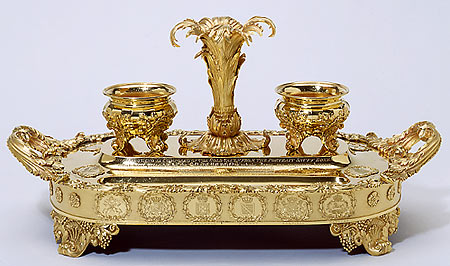 At any antiques show you will encounter inkstands and inkwells without perhaps appreciating the widespread collector interest in such items.
At any antiques show you will encounter inkstands and inkwells without perhaps appreciating the widespread collector interest in such items.For anyone selling an antique it is always an advantage to have two or three possibilities for attracting customers. Consequently a good quality cast bronze inkwell not only interests the inkwell buff but also the collector of bronzes. And the silver dealer will be happy to sell his standish to either an inkwell collector or a Georgian silver collector.
This is the beauty of inkwells they appeal to more than one group. Furthermore they were made from almost every material imaginable, and in such a variety of designs that they also interest a wide range of collectors.
Inkwells have a fascination probably because many collectors grew up with dip pens and they appreciate the importance of writing over the last 250 years. This usually stimulates the collector to imagine what it might have been like to use an antique pen and inkwell as part of the elaborate writing procedure of yesteryear.
A few of the interesting categories of inkwell which have multi-interest for collectors are listed below.
Figural Inkwells
The majority of figural inkwells were made by casting metal and they were then finished off by hand.Padua and Venetian bronzes date back to the 1400s but these are usually in museums so collectors are more likely to encounter Austrian painted bronzes in the form of owls, 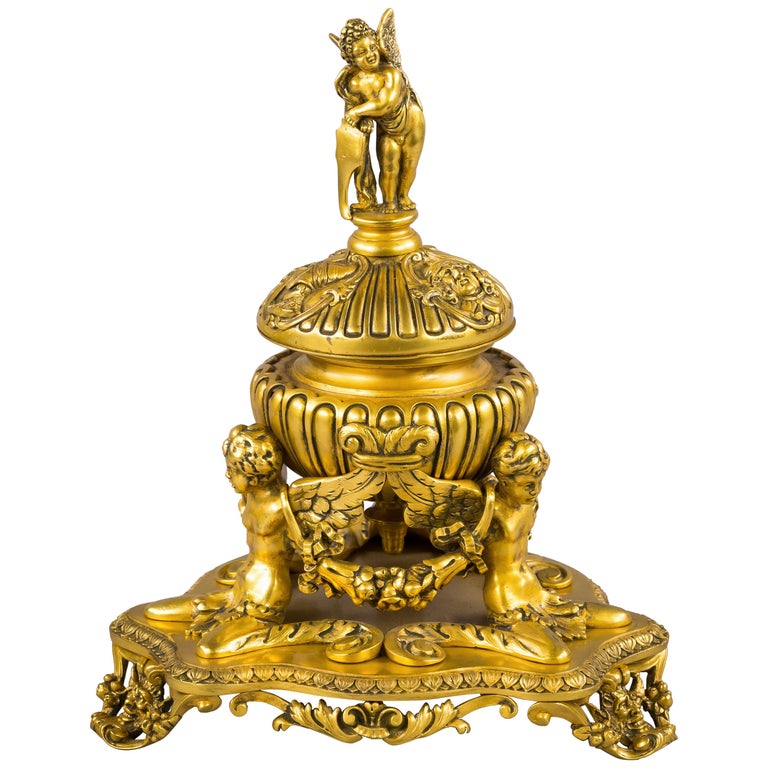 bears and parrots. Apart from bronze there are also some very collectable figurals cast in spelter, silver, pewter and occasionally iron. In fact some of these are so appealing that they have been copied and present the collector with the relatively easy task of recognising a modern reproduction like the ‘modern’ Daniel Lambert wells. A genuine piece has quality, often reasonable wear and excellent detail on any cast fretwork and patterns. The maker of reproductions rarely have time to create such a finish to their work because of time and cost.
bears and parrots. Apart from bronze there are also some very collectable figurals cast in spelter, silver, pewter and occasionally iron. In fact some of these are so appealing that they have been copied and present the collector with the relatively easy task of recognising a modern reproduction like the ‘modern’ Daniel Lambert wells. A genuine piece has quality, often reasonable wear and excellent detail on any cast fretwork and patterns. The maker of reproductions rarely have time to create such a finish to their work because of time and cost.
 bears and parrots. Apart from bronze there are also some very collectable figurals cast in spelter, silver, pewter and occasionally iron. In fact some of these are so appealing that they have been copied and present the collector with the relatively easy task of recognising a modern reproduction like the ‘modern’ Daniel Lambert wells. A genuine piece has quality, often reasonable wear and excellent detail on any cast fretwork and patterns. The maker of reproductions rarely have time to create such a finish to their work because of time and cost.
bears and parrots. Apart from bronze there are also some very collectable figurals cast in spelter, silver, pewter and occasionally iron. In fact some of these are so appealing that they have been copied and present the collector with the relatively easy task of recognising a modern reproduction like the ‘modern’ Daniel Lambert wells. A genuine piece has quality, often reasonable wear and excellent detail on any cast fretwork and patterns. The maker of reproductions rarely have time to create such a finish to their work because of time and cost.Some inkwells have the sculptor´s reputation to enhance their value, e.g. a French well with a bronze bust of the famous Parisian surgeon Baron Guillaume Dupuytren remembered for the hand disease Dupuytren's Contracture. The bust is signed by Antoine Desboeufs, some of whose work is displayed in the Louvre.
Inkwells by masters of detail Edward Stockwell and the prolific William Comyns display the skill of the silversmith and would cost around £750 today. Some less expensive inkwells are no less appealing, for who could resist a second glance at the spelter carp.
Mechanism & Gravity Inkwells
The Victorians and the pre-Empire French innovators were fascinated by trying to make inkwells more efficient with self levelling and automatic filing designs. There are different forms of such displacement inkwells such as pump, syphon or pivoting inkwells.
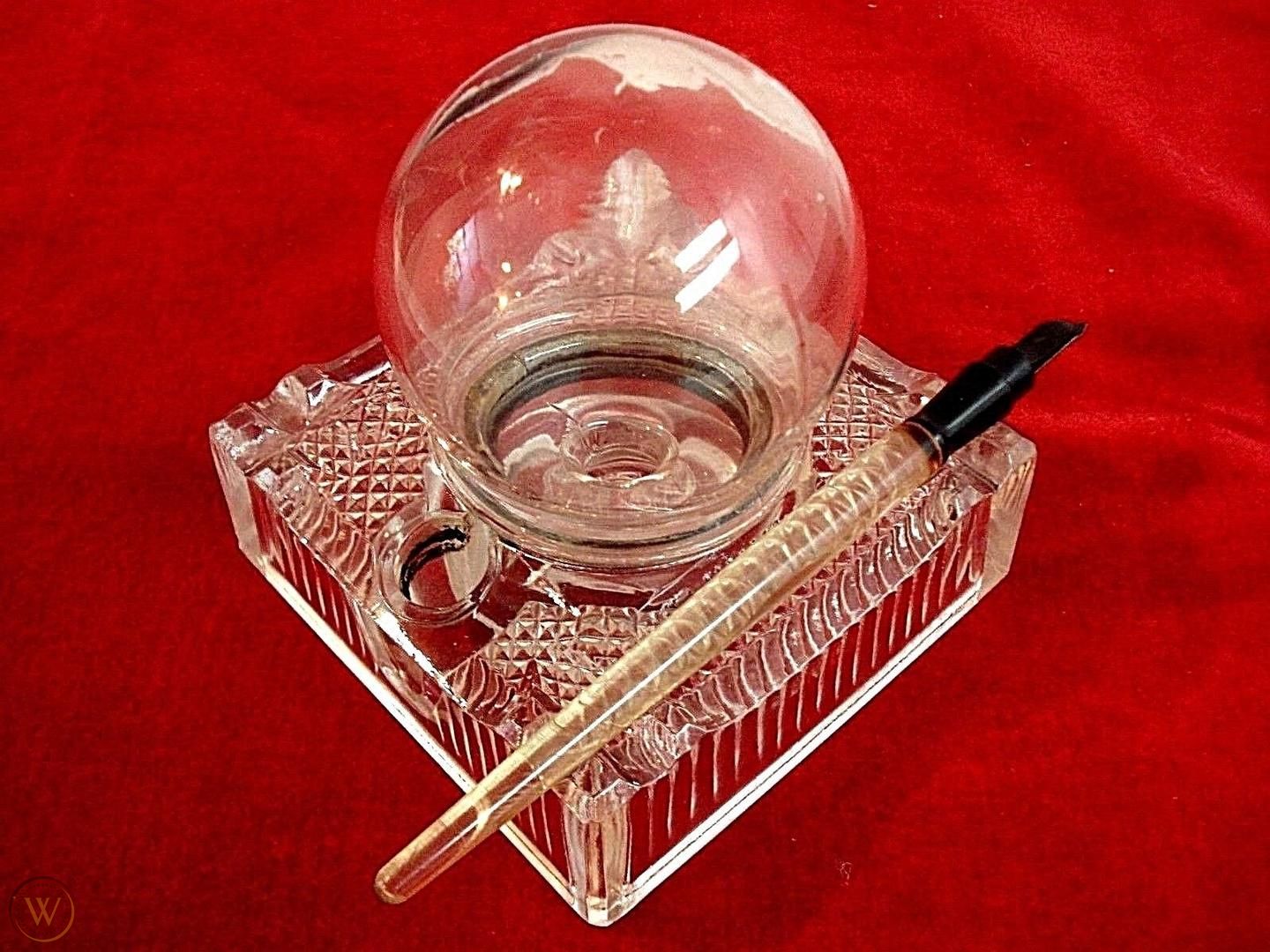 The early French pump wells were made from around 1845 to 1880. The principle is illustrated in the diagram above. As the ink is used up, the weight inside the well is lowered to replenish the ink well in the dipping spout. The exquisite example illustrated has a bell on top to summon the servants after writing. It is interesting that bells frequently figure on 1700s inkwells. Syphon wells use hydrostatic pressure to support a column of ink which kept the ink in the dipping trough at a constant level. Some of these looked like small teapots, whilst others were figural, like the dolphin made by Perry & Co. This firm also made a pivoting cylindrical well which was similar in principle to the snail or French bascule inkwell (bascule means counter balanced). Both these inkwells rotated to present the ink for use through a spout and, when finished with, the well could easily be rotated back into a closed position. The French example were called snails, because the shape is reminiscent of a small shell.
The early French pump wells were made from around 1845 to 1880. The principle is illustrated in the diagram above. As the ink is used up, the weight inside the well is lowered to replenish the ink well in the dipping spout. The exquisite example illustrated has a bell on top to summon the servants after writing. It is interesting that bells frequently figure on 1700s inkwells. Syphon wells use hydrostatic pressure to support a column of ink which kept the ink in the dipping trough at a constant level. Some of these looked like small teapots, whilst others were figural, like the dolphin made by Perry & Co. This firm also made a pivoting cylindrical well which was similar in principle to the snail or French bascule inkwell (bascule means counter balanced). Both these inkwells rotated to present the ink for use through a spout and, when finished with, the well could easily be rotated back into a closed position. The French example were called snails, because the shape is reminiscent of a small shell.At the end of the 1800's Doulton & Co made a constant levelling well for Thomas De La Rue. This was called the isobath well and was made in a number of styles from 1896 to 1910. The ink level was kept constant in the dipping spout by a hemispherical float which rotated as the ink was used up. Most examples are signed and readily attract Doulton collectors.
Prices for pump inkwells vary from around £150 for plain simple examples up to £1000 for the most elaborate gilded and painted porcelain wells. Pivoting wells are rarely less than £200 and a perfect isobath will cost about £350.
Tinplate Novelty Inkwells
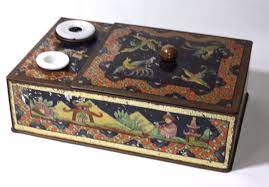 A 1930s visit to the seaside involved saucy postcards and novelty gifts for friends and relatives. Amongst the range of fun items available were inkwells and pens in different guises. Pipes, pistols, buckets and spades and suitcases were on offer and these were often imported from Europe. They are amazingly collectable, particularly in the USA and are rarely less than £100.
A 1930s visit to the seaside involved saucy postcards and novelty gifts for friends and relatives. Amongst the range of fun items available were inkwells and pens in different guises. Pipes, pistols, buckets and spades and suitcases were on offer and these were often imported from Europe. They are amazingly collectable, particularly in the USA and are rarely less than £100.Travelling Inkwells
The portability of inkwells was always important for the medieval scribe but in more modern times The Grand Tour promoted the use of travelling writing equipment. There are some very attractive compendia dating from the 1700s which contain pens, porte-crayons and 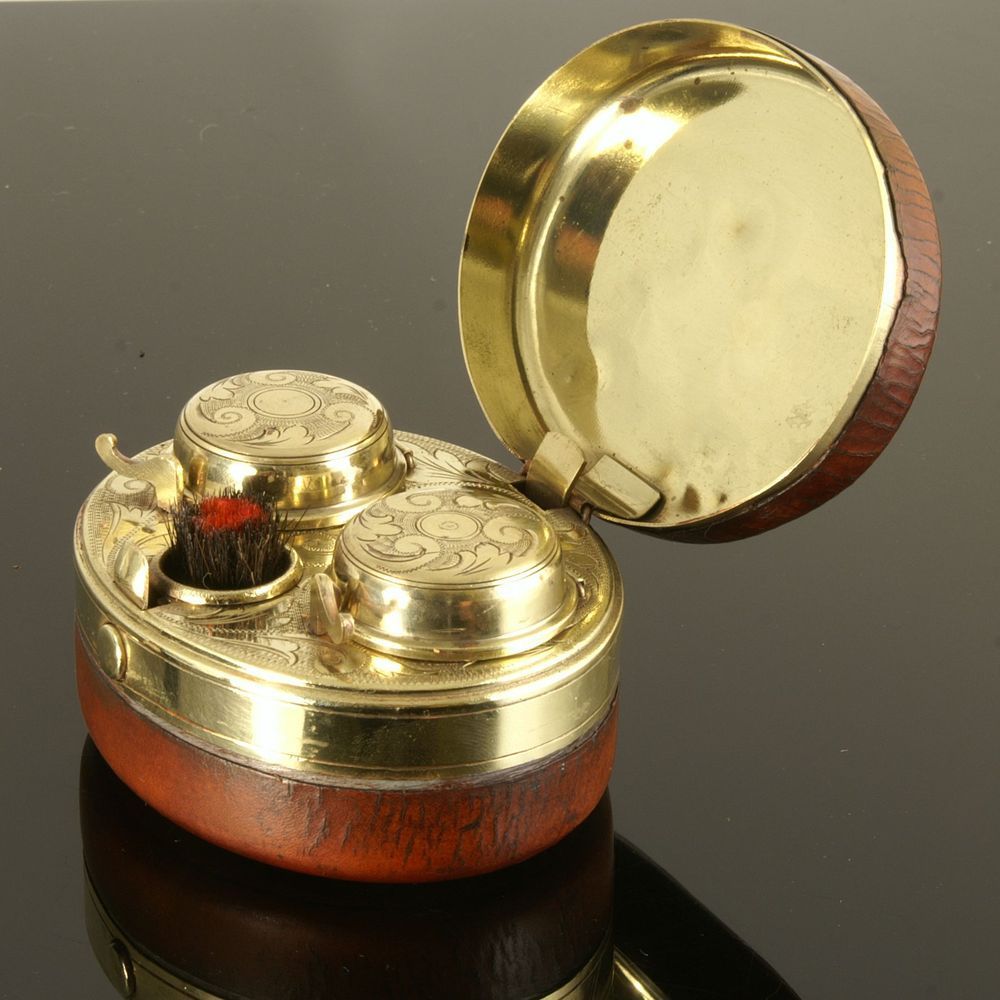 inkwells and many hallmarked silver travelling wells date from the early 1800's. Around 1820, glass became the preferred container for such small wells but they still retained the distinguishing screw sealing writing equipment. There are some very attractive compendia dating from the 1760s which contain pens, porte-crayons, and inkwells and many hallmarked silver travelling wells date from the early 1800s. Around 1820, glass became the preferred container for such small wells but they still retained the distinguishing screw sealing cap which had been part of the metal cover/lid section.
inkwells and many hallmarked silver travelling wells date from the early 1800's. Around 1820, glass became the preferred container for such small wells but they still retained the distinguishing screw sealing writing equipment. There are some very attractive compendia dating from the 1760s which contain pens, porte-crayons, and inkwells and many hallmarked silver travelling wells date from the early 1800s. Around 1820, glass became the preferred container for such small wells but they still retained the distinguishing screw sealing cap which had been part of the metal cover/lid section.
 inkwells and many hallmarked silver travelling wells date from the early 1800's. Around 1820, glass became the preferred container for such small wells but they still retained the distinguishing screw sealing writing equipment. There are some very attractive compendia dating from the 1760s which contain pens, porte-crayons, and inkwells and many hallmarked silver travelling wells date from the early 1800s. Around 1820, glass became the preferred container for such small wells but they still retained the distinguishing screw sealing cap which had been part of the metal cover/lid section.
inkwells and many hallmarked silver travelling wells date from the early 1800's. Around 1820, glass became the preferred container for such small wells but they still retained the distinguishing screw sealing writing equipment. There are some very attractive compendia dating from the 1760s which contain pens, porte-crayons, and inkwells and many hallmarked silver travelling wells date from the early 1800s. Around 1820, glass became the preferred container for such small wells but they still retained the distinguishing screw sealing cap which had been part of the metal cover/lid section.Treen collectors can also acquire ‘travellers’, which are simply bottles encased in attractive wood and these date from the 1700s. By the mid 1800s, registered designs of travelling wells like the Ransome and Casket De La Rue were made in a variety of sizes. Small leather-covered button release wells were made usually to fit into small cases.
There is a trend to call any small well a travelling well, but this is incorrect. Travelling wells were specifically designed for their use and they are not `novelty´pieces!
Horn Inkwells
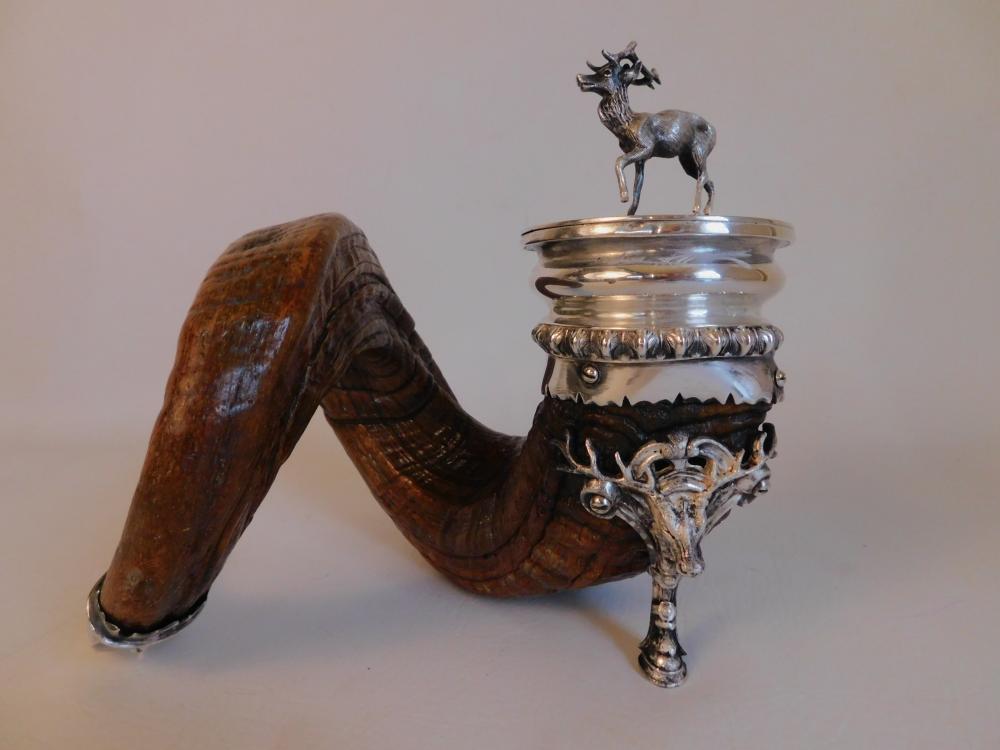 Horn has been used for ink since the 500s, because it had a resistance to the corrosive acid inks of medieval times. It was the most common ink-well liner until glass took over in the 1700s. Horn collectors usually acquire a 1600s horn inkwell which normally has a sander on the base and, if they are fortunate, a complete 1700s penner.
Horn has been used for ink since the 500s, because it had a resistance to the corrosive acid inks of medieval times. It was the most common ink-well liner until glass took over in the 1700s. Horn collectors usually acquire a 1600s horn inkwell which normally has a sander on the base and, if they are fortunate, a complete 1700s penner.American Inkwells
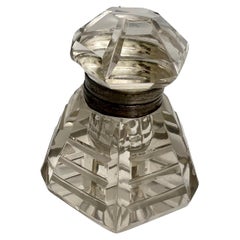 Inkwells by US makers are not frequently encountered in Britain but examples by Gorham, Heintz and Tiffany are very desirable. These are just three makers who produced inkwells, usually in bronze or silver, and there are other US makers of style and quality.
Inkwells by US makers are not frequently encountered in Britain but examples by Gorham, Heintz and Tiffany are very desirable. These are just three makers who produced inkwells, usually in bronze or silver, and there are other US makers of style and quality.The lovely green patina of the 1920 Heintz bronzes with silver decoration makes them easy to recognise and these simply-shaped inkwells are often similar in style to Tiffany, who used a metal frame with a coloured glass. The examples illustrated date from the early 1900s. At the end of the 1800s Gorham were major silver manufacturers and the 1893 shell inkwells are typical of their superb quality. Some American pieces are difficult to identify and date but these three companies mark their pieces clearly and all have a serious following in the USA. Most of the examples can be purchased for less than £200.
